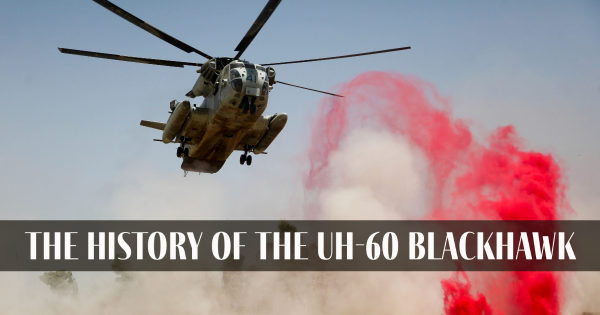Comprehending the Mechanics and Engineering Behind Uh 60 Helicopters
The UH-60 helicopter, commonly recognized as the Black Hawk, stands as a peak of modern-day rotorcraft technology, symbolizing a mix of robust engineering and intricate auto mechanics. From its inception to its present versions, the evolution of this aircraft showcases a blend of innovation and functionality. As we peel off back the layers of the UH-60's style, a globe of complex systems and careful engineering comes to light. Recognizing the auto mechanics and engineering behind this flexible aircraft unveils a realm where precision satisfies power, and where each element plays an essential role in accomplishing flight.
History of UH-60 Helicopters
The history of UH-60 helicopters traces back to the late 1970s when the USA Army sought a flexible and sophisticated utility helicopter to replace its aging fleet. In reaction to this need, the Sikorsky Aircraft Company created the UH-60 Black Hawk helicopter. Presented in 1979, the UH-60 swiftly came to be a staple in military operations because of its impressive abilities.
The UH-60 was designed to master a selection of objectives, consisting of troop transport, clinical discharge, electronic warfare, and unique operations. Its capability to adjust to different roles made it an important asset to the united state Military and various other military forces worldwide
For many years, the UH-60 platform has undergone several upgrades and variants to enhance its efficiency and equal evolving mission demands. These helicopters have seen comprehensive solution in conflicts such as the Gulf War, Afghanistan, and Iraq, showcasing their dependability and convenience in varied functional settings. The UH-60's abundant background is a testimony to its long-lasting heritage as a top utility helicopter.

Engine and Power Equipments
Making use of innovative propulsion modern technology, UH-60 helicopters are furnished with innovative engine and power systems to make certain optimum efficiency and reliability in a variety of operational scenarios. The UH-60, frequently referred to as the Black Hawk, is powered by 2 General Electric T700-GE-701D engines, each efficient in delivering up to 1,940 shaft horsepower. These turboshaft engines give the essential drive for the helicopter to execute its objectives efficiently, consisting of army transport, clinical discharge, and battle assistance.

Rotor System and Aerodynamics
How do the blades system and aerodynamics of UH-60 helicopters add to their operational effectiveness and trip abilities? The rotor system of the UH-60 helicopter plays an important role in supplying lift and propulsion.
The rules of aerodynamics likewise play a crucial role in the efficiency of UH-60 helicopters. The structured fuselage and rotor blade design lower drag, allowing the helicopter to accomplish greater rates and better gas effectiveness. The wind resistant layout of this contact form the UH-60 also contributes to its ability to run in varied ecological conditions, including warm temperatures and high altitudes.
Avionics and Flight Control Equipment

In its complex control with the blades system and aerodynamics of UH-60 helicopters, the avionics and flight control systems create a crucial network of modern technologies forming the aircraft's operational capacities. In the UH-60, these systems consist of digital displays, interaction radios, GPS navigation, climate radar, and auto-pilot systems.
The flight control systems of the UH-60 are in charge of converting the pilot's inputs into the appropriate changes to the rotor system, ensuring secure flight and maneuverability. These systems are composed of hydraulic actuators, servos, and computers that interact to regulate the tail and major rotors, as well as various other flight control surface areas. By exactly managing the helicopter's trip dynamics, these systems enable pilots to execute a large range of goals, from transport and search-and-rescue to battle operations, with accuracy and confidence.
Duty and Applications in Aeronautics
The role and applications of avionics and trip control systems in aviation are indispensable to guaranteeing the efficient and risk-free procedure of aircraft, consisting of UH-60 helicopters. Avionics systems in UH-60 helicopters include a variety of digital systems that help in navigating, communication, tracking, and managing numerous aircraft functions. These systems include digital display screens, autopilot systems, interaction radios, general practitioner navigation devices, and climate radar. Trip control systems play a critical duty in maneuvering the helicopter airborne, keeping security, and ensuring precise movements. The fly-by-wire modern technology used in modern UH-60 helicopters converts pilot inputs into electronic signals, which are then interpreted by the flight control computer systems to adjust the aircraft's control surfaces. Additionally, these systems incorporate security attributes such as auto-pilot check my site settings, surface recognition warning systems, and security augmentation systems to improve the general security and functional abilities of the UH-60 helicopters in different missions, including troop transport, medical emptying, search and rescue, and aerial firefighting.
Conclusion
In final thought, the UH-60 helicopter is a versatile aircraft with an abundant history and advanced design. Its engine and power systems, blades system, aerodynamics, avionics, and trip control systems all function with each other to make it a reputable and effective maker.
In its intricate control with the rotor system and aerodynamics of UH-60 helicopters, the avionics and trip control systems create a vital network of innovations forming the airplane's operational capabilities.The flight control systems of the UH-60 are accountable for translating the pilot's inputs into the proper changes to the blades system, ensuring steady trip and maneuverability. Avionics systems in UH-60 helicopters encompass a variety of try these out electronic systems that aid in navigating, communication, tracking, and managing different airplane functions. In addition, these systems incorporate safety features such as autopilot modes, surface awareness alerting systems, and stability augmentation systems to enhance the total safety and security and operational capacities of the UH-60 helicopters in numerous missions, consisting of troop transport, medical evacuation, search and rescue, and airborne firefighting.
Its engine and power systems, rotor system, aerodynamics, avionics, and flight control systems all work with each other to make it a trusted and effective device.